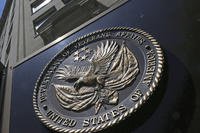The Navy Department wants more than $205 billion for thousands more sailors, new ships, unmanned vessels and aircraft that will help prep pilots to battle adversaries in the air. But the service also plans to send one of its aircraft carriers into retirement early.
The department's 2020 budget request, released Tuesday, includes $115 billion in base funding for the Navy and another $46 billion for the Marine Corps.
The Navy's end strength could jump from 335,400 in fiscal 2019 to 340,500 next year, according to the budget request. The bulk of the increase will be on the enlisted side. Sailors will also be part of a 3.1 percent pay increase next year, requested across the defense department.
The service will retire the aircraft carrier Harry S. Truman as it invests in the Ford-class carrier. The 2020 budget request includes $2.3 billion toward its third and fourth Ford-class carriers.
"As part of this budget request, we made the difficult decision to retire the [Truman] in lieu of its previously funded refueling complex overhaul that was schedule to occur in [fiscal] 2024," the budget documents state. The funding will be bumped to more "diversified investments," according to the plan, including unmanned vessels.
As the Navy progresses toward a planned fleet of 314 ships by fiscal 2023, up from 289 today, it's also requesting a robust shipbuilding budget: $23 billion in total. The funds will include, among other vessels, the very first guided-missile frigate as part of the Navy's new FFG(X) program and two large unmanned surface ships.
The frigate, which follows the Navy's rapidly concluding littoral combat ship program, is expected to be able to tackle a variety of missions so larger combatants can spend time on bigger operations.
The unmanned surface ships are part of a broader Navy investment in unmanned vehicles. The budget request also includes three dozen unmanned undersea vehicles and two more MQ-4C Tritons, a high-altitude unmanned aerial vehicle that conducts surveillance.
Plans include money toward a Ford-class carrier; three Virginia-class submarines; three destroyers, a guided-missile frigate; two John Lewis-class oilers; and a pair of towing, salvage and rescue ships.
The Navy is also investing in 11 F-5 Tiger IIs, tactical fighter and attack aircraft that provide simulated air-to-air combat training.
"The Department is procuring F-5E/F aircraft from the government of Switzerland in support of the [Navy and Marine Corps] adversary requirements," the budget documents state. "The F-5 is an agile, highly maneuverable, reliable supersonic fighter."
The Navy also wants 10 more F-35C Joint Strike Fighter jets and two dozen F/A-18E/F Super Hornets.
A significant portion of the Navy's total budget request -- $45 billion -- is in the category of overseas contingency operations, or OCO, a bucket ostensibly reserved for warfighting.
However, $35.5 billion of that OCO funding is programmed as "OCO for base," meaning it will be used as part of the Navy's base budget. Due to sequestration budget caps that will take effect next year, all the military services are using uncapped OCO accounts to plus-up overall funding.
This story will be updated.
-- Gina Harkins can be reached at gina.harkins@military.com. Follow her on Twitter @ginaaharkins.












